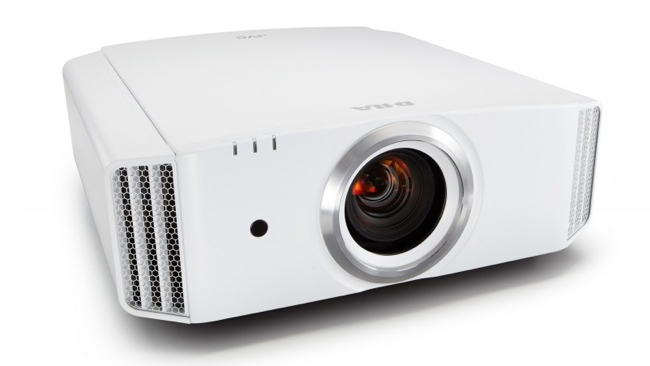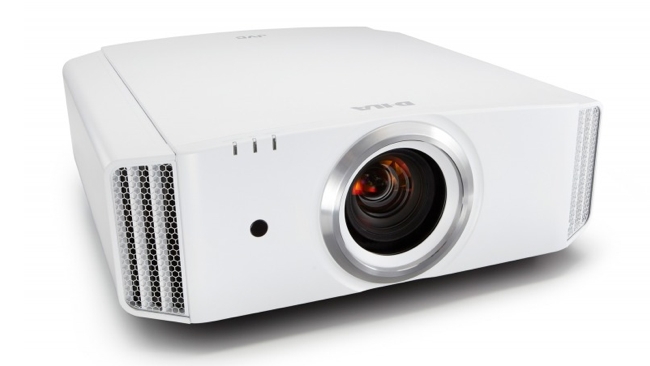
 JVC DLA-X55
JVC DLA-X55
JVC has always made good projectors. And they've always used really good technology that's been kind-of hard to understand, because it takes a lot of explaining. But if all you want is good pictures, the tech doesn't really matter, because if it looks good, it is good
But JVC has just launched a product that, again, uses advanced proprietary technology, and this time, it's confusing. It's confusing because the projector claims to project images in 4K resolution, but doesn't accept 4K inputs.
What's going on here?
So what exactly is JVC doing here? Well, they're certainly not trying to deceive anyone. What they're actually doing is providing an intermediate-stage projection system that gives a genuine impression of higher resolution while watching "mere" HD content.
If there is a problem here, it's that JVC hasn't explained their e-shift 2 process very well. Which is a shame, because it's very clever - in surprising ways - and is really quite admirable.
HDTVtest, "the UK's No.1 HDTV Review Site" had a close look at the DLA-X55 projector, and, for the first time as far as we know, gave a really good explanation of how JVC's Pixel-shifting technique actually works, and how it actually improves the look of HD material.
Here's what they had to say about it:
E-Shift 2: 4K-like images with 1080p hardware
JVC’s mid-range and higher projectors feature a unique optical system, which is promoted as “4K E-Shift 2″. Its intended purpose is to produce higher-than-1080p images using existing 1080p LCOS chips, by rapidly alternating the position of the projected pixels.Although some parts of their image processing chain do operate at 4K resolution, there are no true 4K projectors in JVC’s current lineup: they can’t accept native 4K input (of which essentially none exists in consumer hands anyway) and therefore can’t display finely detailed 4K images (the only projector we’ve tested that can is the luxury-priced Sony VPL-VW1000ES). However, one stage of their image processing operates at 4K level.
Interestingly, JVC’s UK web site does list these models under a category called “3D and 4K Projectors”, but you’ll notice elsewhere that JVC UK are careful to refer to this high resolution only with the additional wording that it is “achieved with optical engine featuring e-shift 2 Technology”.
E-Shift technology exploits both spatial and temporal means to present a 4K-like image, all while using standard 1080p imagers in the projector. First, the projector takes 1080p video and scales it to 4K resolution at the video processing stage. There are several detail enhancement algorithms at this stage, which JVC calls “Multiple Pixel Control”, or “MPC”, the name apparently alluding to a standard feature of scaling (and associated processing), whereby groups of pixels are analysed so that intelligent guesses can be made when interpolating up to a higher resolution. We’ll talk about this some more in the next section – for now let’s stick to talking about the optical side of the system.So, now we have a 4K sized image, but we don’t have 4K sized imagers to show it with. This is where e-shift 2 steps in. That 4K-sized image is cut into two sub-frames by subsampling it in a “quincunx” pattern, which alternates on each sub-frame. Remember, 3840×2160 (one of the resolutions referred to as “4K”) is exactly double that of the Full HD 1920×1080. That means that the video processor can move through the 4K-sized image in a diagonal zig-zag using half of the pixels, getting us back to 1920×1080. That pattern is then repeated for the second sub-frame, only this time, the pixels that were skipped over for the first sub-frame are selected instead.
These two sub-frames are then displayed on the high-speed 1920×1080 LCOS chips in rapid succession, in the same way that the Left and Right eye components of 3D images are during stereoscopic 3D display (they’re temporally interleaved). The first group of pixels (the first sub-frame) would be shown, and then a split-second later, in the same position, the second group.
The two sub-frames are displayed so quickly that, for the most part, the human visual system sees them as one complete image, thanks to persistence of vision. However, high-speed drive (the temporal element of e-shift 2) is not enough to give the impression of a higher resolution output. It’s not enough for the additional pixels to be displayed briefly in the same space as the original ones – that would degrade the resolution, not improve it. The second sub-frame has to appear at a slightly different position on the screen.
This is achieved by exploiting a property of polarised light called birefringence, not by physically moving the panels (thank goodness). A separate component in the optical path (JVC calls it the “e-shift device”) causes the image to be optically shifted down and to the right by approximately half a pixel, in time with the LCOS panels drawing the second sub-frame (similarly to how 3D active shutter glasses deliver the two sub-frames which make up a 3D image to the viewer’s eyes, only instead of blocking light like 3D glasses would, the e-shift device instead moves it, inside the projector). So, two 1920×1080 images are overlaid diagonally offset, creating the effect of a doubled 3840×2160 “Ultra HD”/4K frame. In this way, the 1920×1080 panels can produce pixels in two different positions on the screen, without the panels ever having to move.One question we’re posed to JVC: given that the projector has the internal bandwidth for 4K video processing, why can it not accept a 4K feed via HDMI, and do its best to display it by sending it through the same e-shift2 system as the 4K Upscaled images? We wondered if JVC had perhaps omitted such a feature because the results would fall too far short of what future true 4K projectors will offer, but in reality, the reason is much simpler: to accommodate 4K input would require a major redesign of the projector, and given that there are no consumer 4K sources, it’s easy to see why this hasn’t been a priority for JVC.
The most pressing question for consumers is, “does it actually look better?” On the whole, yes. Images projected using the 4K upscaling and e-shift2 optical output have the appearance of having higher resolution, and feature smoother diagonals. What’s more, there is hardly any pixel grid visible on the image as a result of the system.
With that in mind, you might be surprised to read that turning on the e-shift system causes the actual resolution, as seen with single-pixel line pairs in resolution test patterns, to drop. Black and white alternating line pairs, used to assess resolution, appear more defined when the projector is operating in its “original” 1080p mode. And yet, with actual content, we still preferred to have the e-shift system enabled. We wondered if the black and white line pairs could cause temporal crosstalk between Sub-frame A and Sub-frame B. Remember, in a resolution test pattern, the lines are packed directly beside each other, and to display this with e-shift, some of the pixels on the imager may be put in a position where they must rapidly switch between white and black. Therefore, we might be seeing lessened resolution with these patterns due to the extreme changes we’re asking the LCOS chips to make. (The idea that static resolution can be impacted by the panels’ motion resolution is a concept that still bends our minds). Real movie content is not so synthetic and challenging as this, which would explain why we had no complaints during actual usage: for example, asking the LCOS chips to change from one extreme of the dynamic range to another (white to black) is a harder task than asking them to draw, for example, similarly coloured pixels in an actors’ face.
And on top of all that, there is also the good old fallback of viewing distance. Even with our test pattern torture test, resolution loss just isn’t visible from a few feet back, where even a good pair of eyes becomes the limiting factor in getting crisp images into your brain. Regardless, the choice of whether or not to use this novel system is in the viewer’s hands. We certainly found it to be beneficial, all things considered, and are still impressed that someone thought of it.
You can read their full article here.
Tags: Technology



Comments